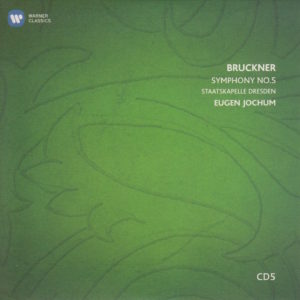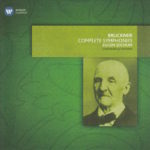 Today’s conductor of Anton Bruckner’s Symphony No. 5 in B-Flat Major (WAB 105) – nicknamed “Tragic,” “Church of Faith,” or “Pizzicato” symphony (for reasons I’m still discovering), is German-born Eugen Jochum (1902-1987), unarguably one of the most highly respected interpreters of Anton Bruckner’s music who ever lived.
Today’s conductor of Anton Bruckner’s Symphony No. 5 in B-Flat Major (WAB 105) – nicknamed “Tragic,” “Church of Faith,” or “Pizzicato” symphony (for reasons I’m still discovering), is German-born Eugen Jochum (1902-1987), unarguably one of the most highly respected interpreters of Anton Bruckner’s music who ever lived.
I have two CD box sets conducted by Jochum – this one, on the Warner Classics label, and one on the Deutsche Grammophon (DG) label. I chose to listen to the symphony from the DG set before the one from the Warner Classics label because the DG-label recordings are older. (I figured alpha by conductor and then chronological by performance was a fair enough delineator.)
I first encountered Maestro Jochum in this box set (I call it the “green one”) on Day 7 of my 144-day project. He conducted Symphony No. 1.
Then again on Day 23, Symphony No. 2.
And again on Day 39, Symphony No. 3.
And, most recently, on Day 55, Symphony No. 4.
From my very first post about the Jochum “green” box:
 The orchestra for this morning’s symphony was Staatskapelle Dresden, one of the world’s oldest orchestras (founded in 1548 by Maurice, Elector of Saxony). Jeepers, creepers. That’s truly amazing.
The orchestra for this morning’s symphony was Staatskapelle Dresden, one of the world’s oldest orchestras (founded in 1548 by Maurice, Elector of Saxony). Jeepers, creepers. That’s truly amazing.
The booklet of liner notes in this box set is minimal (no version of symphony listed, and no running-time totals for each CD listed), and not as interesting as the one in the box yesterday. However, there are a couple of good comments from the section of the essay titled “Eugen Jochum as Bruckner conductor,” written by Karl Ganzer:
Among the innumerable conductors who strove for a faithful interpretation of Bruckner’s symphonies, Eugen Jochum was…rightly considered the leader Bruckner exponent of his day, and his reading of the nine mature symphonies are characterised by a meticulous, balanced consideration of symphonic form. The spiritual foundations and metaphysical substance of Jochum’s approach were based on the affinity this Swabian conductor felt for the Austrian symphonist in whom he had believed so deeply from an early age.
The spirituality of Jochum’s music-making was most evident in his love for the German Romantic tradition, though he was also an energetic and successful champion of certain contemporary composers such as Paul Hindemith, Carol Orff and Werner Egk. For many people, however, Jochum remains their undisputed guide who introduced them to Bruckner’s musical universe.
I’m sorry. But Bruckner’s Symphony No. 5 is boring me to tears. I was thrilled with Nos. 1-4. Electrified, in fact. But Symphony No. 5 just lies there for me. It’s tedious, inscrutable, and remarkably standoffish. I simply cannot get engaged in this symphony.
Oops. Did I type that out loud? I was supposed to be using my inside-my-head-but-not-typing-it voice.
But, enough subjectivity for now.
Here are the nuts and bolts.
Bruckner’s Symphony No. 5 in B-Flat Major (WAB 105) composed in 1875-1876
Eugen Jochum conducts
I have no idea which version Jochum chose; it’s not listed in the CD booklet/liner notes
Staatskapelle Dresden plays
The symphony clocks in at 77:28 (that’s getting really, really close to “Yikes!” territory)
This was recorded in Dresden, Germany, in 1980
Jochum was 78 when he conducted it
Bruckner was 51 when he finished composing it
This recording was released on the Warner Classics label
Bruckner wrote his symphonies in four parts. The time breakdown of this one (Symphony No. 5 in B Flat Major, version unknown), from this particular conductor (Jochum) and this particular orchestra (Staatskapelle Dresden) is as follows:
I. Introduction (Adagio) — Allegro. B-flat major……………………………21:26
II. Adagio. Sehr langsam. (Very slowly) D minor……………………………19:16
III. Scherzo. Molto vivace D minor…………………………………………………13:04
IV. Finale (Adagio) — Allegro moderato. B-flat major…………………..23:42
Total running time: 77:28
And now for my subjective assessment:
My Rating:
Recording quality: 4
Overall musicianship: 4
CD liner notes: 3 (minimal information, one essay)
How does this make me feel: 4
This is a fine recording, with no brassy/harsh sound to the horns, a fullness in the orchestra that allows me to hear every instrument clearly. The horns are mellow. The stringed instruments pizzicato their little hearts out.
My favorite movements are III (Scherzo) and IV (Finale). They offer the liveliest and most interesting passages.
Still, I haven’t not been wowed by any cool little snippets in No. 5 the way I was in parts of the first four. I remember getting really excited about a passage in one of the first three symphonies and making my wife sit down and listen to it.
I haven’t done that with Symphony No. 5. That’s because there aren’t any really creative passages in Symphony No. 5. Not to my ears.
So, even though a particular recording and conductor’s interpretation may blow me away in my review of Bruckner’s Fifth, it’s not necessarily because of the material I’m hearing. It’s because of the way its recording or the energy with which it’s played.
Take this recording, for example. It’s notably better than yesterday’s. But it’s not blowing me away with excitement. Seriously, if I judged Bruckner by his Fifth, I’d judge him to be a talented, but uninspired composer.
I know, I know. Some people consider the Fifth to be his masterpiece.
But I’m not one of them.
Well, in all fairness, my day was one from hell. Full of distractions, side projects, taking my wife to the airport for another trip to Nashville, not feeling well, etc.
So, it’s entirely possible my frame of mind colored by listening experience.
